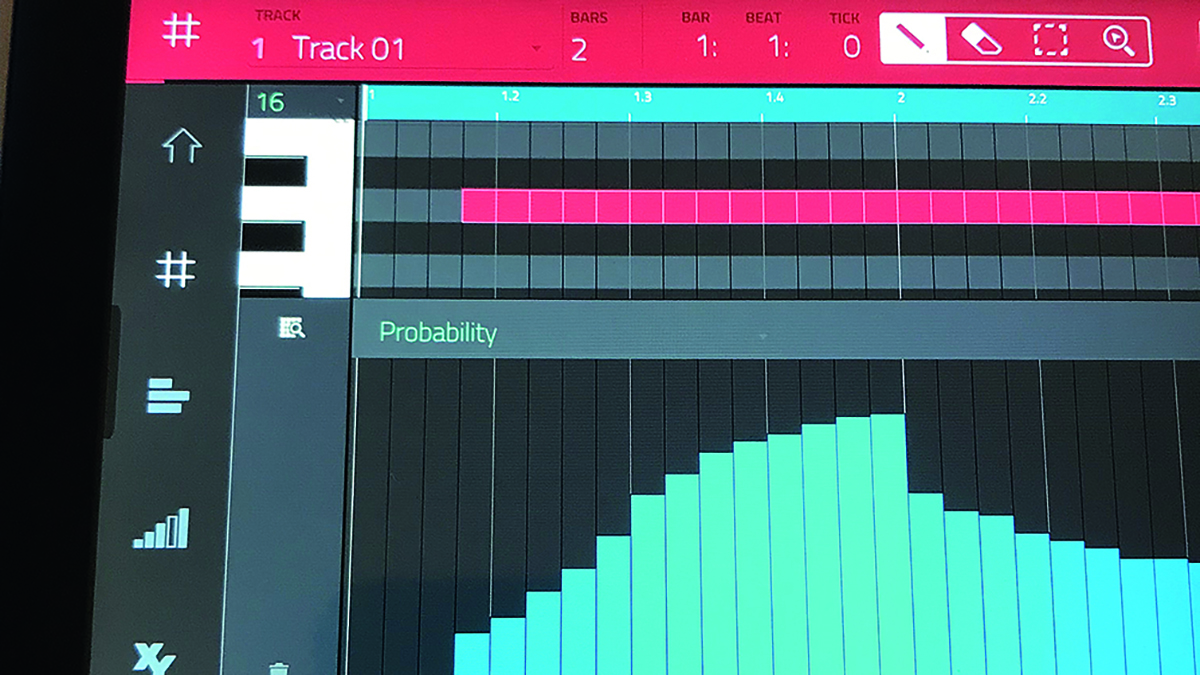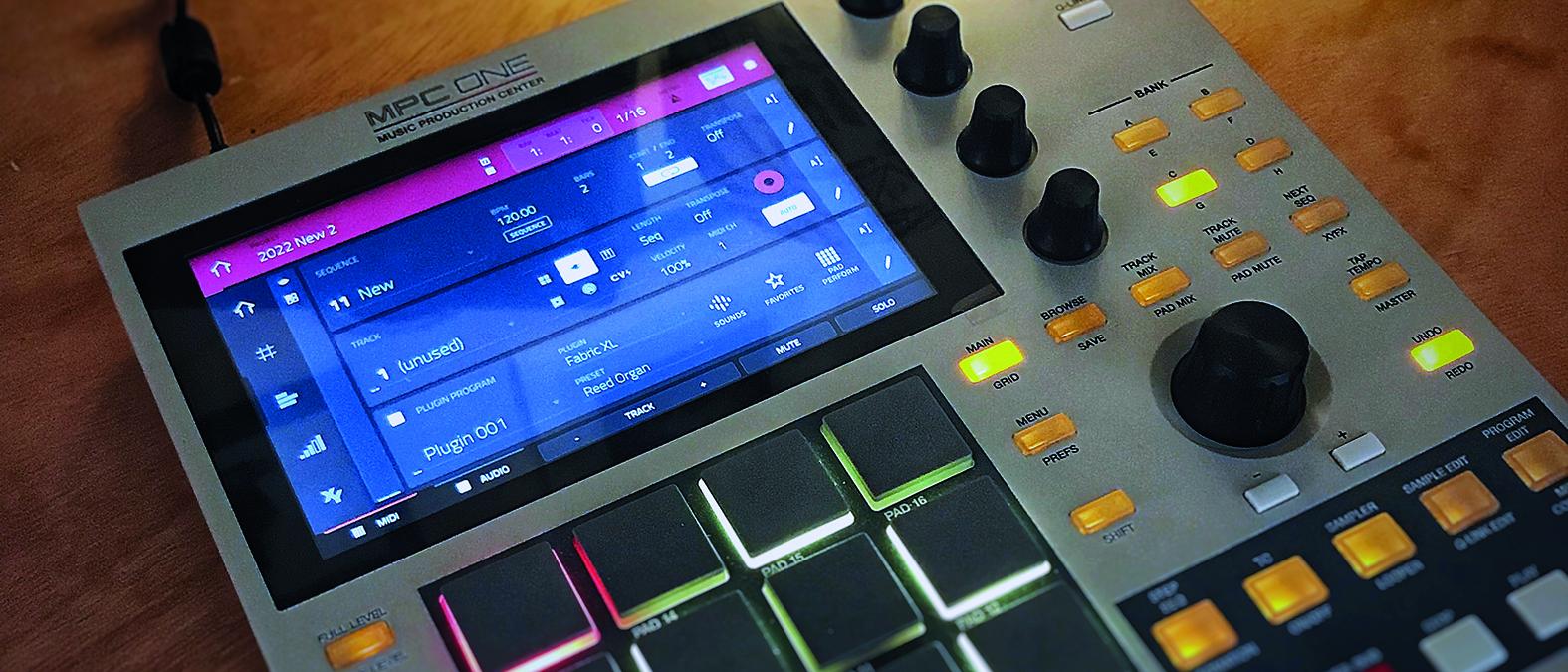MusicRadar Verdict
The One trims the full MPC experience down to sit at a more affordable price point, making only a few, largely acceptable, compromises along the way.
Pros
- +
New instruments in 2.11 sound exceptional and really make the MPC One an even more fully-fledged production machine.
- +
Small but important workflow tweaks in the new OS help speed up your process.
- +
Tons of plugin effect choices.
- +
Those heavenly Akai pads are still a joy to use.
Cons
- -
New instruments can take a while to load.
- -
Hefty price tag for six new instruments.
- -
Having a few different ways to accomplish the same task can at times be confusing.
MusicRadar's got your back
What is it? Akai MPC One
The MPC One is the smallest and lightest of the range, at just over 2kg. Conversely, despite being the most readily transportable, there’s no battery here, meaning it needs a power supply at all times. This is a shame, perhaps, but the inclusion of a rechargeable battery would have driven up both the price and weight, negating the device’s USP.
Despite the smaller size, Akai has done an excellent job of arranging the One’s layout so as to include as much control as possible. The same high-quality 7-inch touchscreen is included, along with the four Q-Link rotaries and the main browser knob. The clicky plastic buttons don’t feel as nice as their rubber counterparts on the MPC Live II but, oddly enough, the One actually has more front panel controls, with dedicated buttons for functions such as Program Edit and Q-Link edit that aren’t there on its counterpart.
The pads themselves have been downsized a little, making them closer in size to those found on the Novation Launchpad Pro, but they still feel excellent to play and are up there with the most responsive you’ll find on any MIDI controller.
The multicore CPU and RAM under the hood is identical to that of the MPC Live, so there’s no difference when it comes to the software experience itself. The two areas where notable concessions have been made are the onboard storage and hardware I/O. On the former front, the One trims the 16GB drive found in the MPC Live down to just 2GB, with a significant reduction in pre-loaded sounds as a result (although the 2GB sound library hardly feels stingy). Fortunately, there are still USB and SD card slots included, making it easy to expand the storage options.
Elsewhere, the ins and outs have been trimmed down to the bare minimum needed to leave the MPC One as a fully functioning workstation. The additional output from the Live have been removed, leaving just a stereo pair master output and headphone port. The inputs too, are trimmed back to just one stereo pair, losing the Live’s phono input. This makes it slightly more complicated to sample directly from a vinyl turntable, but it’s not massively problematic – if you’ve got a deck for sampling, odds are you already have a mixer or amp to hand that can act as a go-between.
Alongside these, there’s one MIDI input and one output, and one each of USB-A, USB-B and ethernet network connection. Of these, it’s the Live’s multiple USB-A ports we’d miss most, as we like being able to use them to load samples and run an external MIDI device simultaneously. On the whole, though, nothing’s missing that would be a dealbreaker for most users. The full crop of CV minijacks remains – a nice touch.

Performance and verdict: Akai MPC One
While it was already a very featured packed device at its release, Akai has kept updating the MPC One with a plethora of updates that not only include workflow enhancements but new instruments and effects altogether. The most recent update, OS 2.11, is quite a game-changer.

Akai MPC Live II
A truly go-anywhere music production experience – and now better equipped than ever.
Roland MC-707
The flagship of Roland’s revived groovebox range combines a ton of quality synth and drum machine sounds, impressive effects and audio looping.
Pioneer DJ Toraiz SP-16
Pioneer’s standalone sampler borrows a number of ideas from the classic MPC format but includes features aimed at DJs and live performers.
Native Instruments Maschine MK3
If you’re not concerned about being bound to a laptop, NI’s interface-equipped controller offers a slick, tight music making experience.
There have been many small workflow enhancements, but one of the biggest introduced in the new 2.11 OS update, is the new Sounds browser, which allows you to quickly browse through all of the instruments’ presets at once.
The Sounds Browser also features a shortcut to the new Setlists feature, which allows users to quickly organise stored projects for recall during a live performance. This is incredibly handy, as the more long-winded route of opening up a project via the Browser window is definitely not something you’d like to be doing in front of a crowd!
A huge update in the new MPC OS, especially for those coming from the Elektron workflow, is the ability to now add probability to any note in the sequencer, whether it’s internal or sending MIDI externally.
That brings us to the new instruments available in the MPC One. First introduced with the new MPC Key 61, there are now six new instruments available at the price of $499 for the entire package. Available to users, Fabric, OPx-4 (an FM synth), Organ, Stage Piano, Stage EP, and Studio Strings all sound top-notch.
Endlessly explorable
While $499 might seem excessive at first, diving deeper into these new instruments shows a level of depth that isn’t apparent from the surface. For example, the Stage Piano instrument features the choice of four real pianos, sampled in multi-layer format, with a total size of 2GB of samples! There’s also a huge amount of articulation control available, including the ability to adjust hammer falls, sustain levels, staccato, noise, and much more.
OPx-4 is a hugely versatile four-operator FM synth with high-quality built-in effects, eight macro knobs, and a 32-slot FM modulation matrix. Exploring just this one instrument alone would take weeks if not months. Akai have also given each of these instruments banks and banks of presets, so you aren’t stuck starting with an Init patch and crafting from scratch.
These new instruments and effects, along with the probability and ratcheting, have really made the MPC One an endlessly explorable machine. Whether you’re more into the sampling side, the sequencing angle, or both, the MPC One is a hugely capable production machine and live tool.
MusicRadar verdict: The One trims the full MPC experience down to sit at a more affordable price point, making only a few, largely acceptable, compromises along the way.
Hands-on demos: Akai MPC One
AkaiProVideo
Gabe Miller Music
loopop
Dylan Paris
Specifications
- Type: Portable hardware sampler, sequencer and DAW replacement
- Key features: No Computer Required, Powerful Multicore Processor System, Built-in Stereo Monitors, 16 Full-size Velocity Sensitive RGB Pads, Brilliant 7-inch Multi-Touch Display, 2 GB RAM, 16GB Onboard Storage, Over 10GB pre-installed content, Mac & PC Controller for MPC Software (included), Stereo Inputs, 3 Stereo Outputs, Phono Level RCA Jacks, 2 x MIDI In & 2 x MIDI Out, 4 TRS CV/Gate Jacks, 8 Outputs Total, USB 2.0 Slot for Storage Drives or Midi Controllers for use in Standalone, SD Card Slot, 2 USB 3.0, Expandable SSD Bay
- Contact: Akai
I'm the Managing Editor of Music Technology at MusicRadar and former Editor-in-Chief of Future Music, Computer Music and Electronic Musician. I've been messing around with music tech in various forms for over two decades. I've also spent the last 10 years forgetting how to play guitar. Find me in the chillout room at raves complaining that it's past my bedtime.
“Excels at unique modulated timbres, atonal drones and microtonal sequences that reinvent themselves each time you dare to touch the synth”: Soma Laboratories Lyra-4 review
“I used everything I knew about music”: How Green Day exceeded expectations with their most ambitious song
YouTube just added AI tools that makes musicians, library music and video editors redundant










